14 Types of Black and Brown Caterpillars (Pictures and Identification)
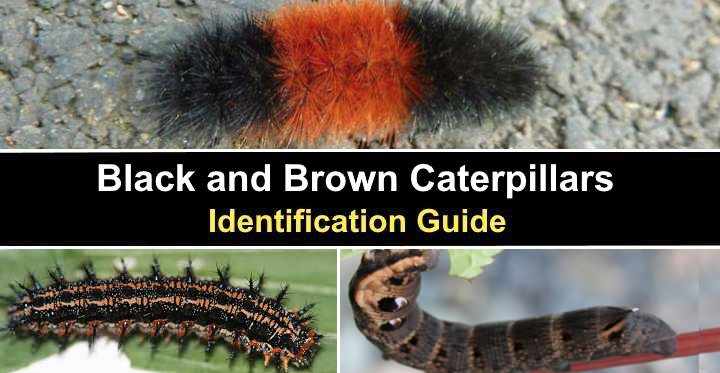
Black and brown caterpillars are the worm-like larvae of moths and butterflies. The most common black and brown caterpillar is the furry banded woolly bear. This hairy crawling insect is covered in black hairy tufts with a bronze-brown band in the middle. Other types of brown and black caterpillars can have smooth bodies, spiny clumps, mottled patterns, or stinging setae (hairs).
This article is an identifying guide to recognizing common types of black and brown caterpillars. Descriptions and pictures of these worm-like creatures will help to identify individual species.
How to Identify Black and Brown Caterpillars
Black and brown caterpillar identification is by the insect’s shape and particular markings. For example, some caterpillars are smooth, whereas others have bumps and eyespots. Also, look for hairs, spiny tufts, pencil hairs, lashes, or fleshy horns. Identifying the caterpillar’s host plant can also help to know the species.
Identifying black and brown caterpillars can be challenging. Caterpillars start life as tiny eggs before the larvae hatch and feed voraciously on plant leaves. Then, as the slug-like insects grow, they go through growth stages (instars). During this time, the shape, color, and appearance of the larvae can change.
For example, the black and brown elephant hawk moth caterpillar (Deilephila elpenor) starts as a slender, bright green caterpillar with a black horn. It then becomes mottled black and brown with conspicuous eye-like patterns as it grows.
Also, the common black and brown woolly bear larva has sparse tufts of short spikes when immature before becoming a hairy caterpillar.
Types of Black and Brown Caterpillars (With Pictures)
Let’s look in detail at the identifying features of common black and brown caterpillars.
Woolly Bear Caterpillar (Pyrrharctia Isabella)

Isabella tiger moth caterpillar is a furry caterpillar with black and rusty brown hairs
The woolly bear (also known as the woolly worm) is a fuzzy black and brown caterpillar. This caterpillar has tufts of fuzzy-looking bristles that are black at either end and reddish-brown or bronze in the middle. The harmless furry caterpillar is covered in stiff hairs. It has a jagged appearance, but it’s not a stinging caterpillar.
Also called the black-ended bear, the woolly bear is more of a black caterpillar when it’s immature. As it grows, it becomes woollier and more reddish as it nears the pupation stage. However, the larva’s distinctive black-brown-black appearance makes it easily recognizable.
Woolly bears grow around 2.3” (60 mm) long. After pupation, the fuzzy caterpillar turns into an attractive orange moth with black spots along its abdomen.
Black and brown woolly bears look cute and cuddly. Although it’s covered in fuzzy spiky hair tufts, it doesn’t have stinging spines, and it’s not a toxic caterpillar. However, some people may experience some skin irritation, so it’s best to leave it alone.
A characteristic trait of the woolly bear is its habit of rolling into a furry ball when it feels threatened. This action has earned the fuzzy bear caterpillar the nickname hedgehog caterpillar.
Woolly bear caterpillars eat a variety of plants such as grasses, milkweed, dandelions, nettles, and other low-growing weedy plants. They also consume dock, aster, goldenrod, plantain, birches, maples, and some grasses. These adaptable caterpillars can thrive in meadows, forests, and gardens.
According to folklore, some people believe that the width of the reddish-brown band on a woolly bear caterpillar can be used to predict the severity of the upcoming winter. The legend suggests that a wider reddish-brown band indicates a milder winter, while a narrower band suggests a harsher one. However, there is no scientific evidence to support this claim, and it is not considered a reliable method for weather prediction.
Black and brown caterpillar identification
The woolly bear is easy to spot in a fall landscape due to its furry appearance and brown band between black ends.
- Adult Stage: Woolly bear caterpillars, eventually undergo metamorphosis and transform into Isabella Tiger Moths (Pyrrharctia isabella). These moths are known for their distinctive coloration, with cream-colored wings and a pattern of small black spots. After the transformation, the adult moths typically emerge during the summer and early autumn months.
- Host Plants: Various plants, including grasses, clover, low-growing vegetation, and weeds including plantain, dandelion, and nettles
- Habitat and Distribution: Meadows, open fields, gardens, and forests in North America, particularly the United States and Canada
- Stinging: No, they do not have stinging hairs. But the bristles can cause skin irritation but are not venoumous
Drinker Moth Caterpillar (Euthrix potatoria)
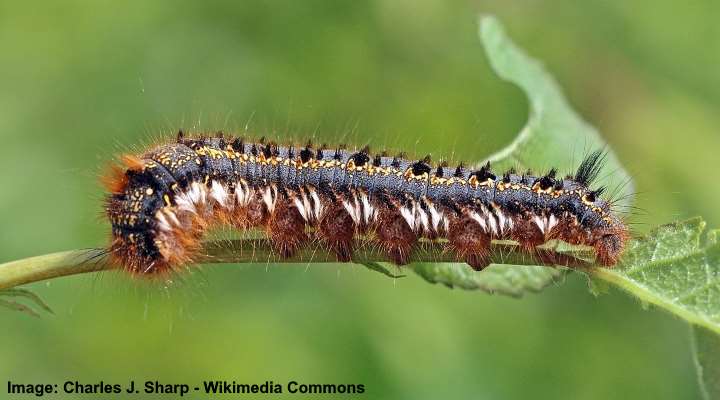
The drinker moth caterpillar is a furry brown, black and white caterpillar
The drinker moth larva is a black and brown caterpillar with tufts of orangey hairs, two rows of yellow or orange dots on its back, and white markings along its sides. Depending on the climate, the caterpillar can look black and orange. The drinker moth caterpillars grow 2.4” (61 mm) long.
The hairy spotted and striped caterpillar tends to feed on grasses and reeds in marshy areas. After pupating, the larva turns into a furry yellow or rusty brown moth.
Black and brown caterpillar identification
The drinker moth caterpillar is identified by its black body, brown fuzzy prolegs, and tufts of orangey setae. In addition, there are small dark brown tufts and yellow or orange speckles on its back.
- Adult Stage: Drinker Moth. It has a robust body with broad wings, displaying a distinctive pattern of brown and cream-colored scales. It typically has a wingspan of around 45-60 millimeters.
- Host Plants: The caterpillars of the Drinker Moth feed primarily on various grasses, including common reed and other aquatic plants.
- Habitat and Distribution: This species is often found in damp or wet habitats, such as marshes, fens, and grassy areas near water bodies, across Europe and parts of Asia.
- Stinging: The caterpillars of the Drinker Moth are not known to be significantly stinging or causing skin irritation in humans. However, handling them with bare hands can occasionally cause mild irritation or an allergic reaction in sensitive individuals.
Garden Tiger Moth Caterpillar (Arctia caja)
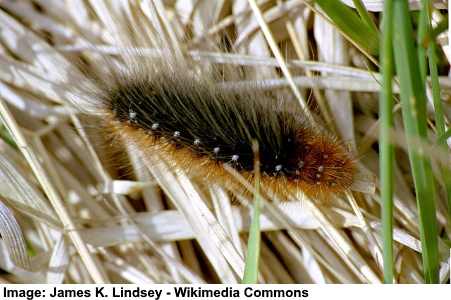
The fuzzy garden tiger moth caterpillar has black, rusty brown and gray hair-like spines
The garden tiger moth larva is a brown and black caterpillar covered in long hairs and spines. These woolly bear caterpillars have a black furry body with a reddish-brown band along their sides. The fuzzy caterpillars develop toxin-filled spines that can cause skin irritation when handled.
Garden tiger moth caterpillars are active in late summer. In warmer climates, like Florida, the caterpillars are still seen in September, and they feed on a wide variety of plants. The woolly bear moth caterpillar turns into beautiful brown and fuzzy orange moths with stunning wing patterns.
Black and brown caterpillar identification
The garden tiger moth caterpillar is identified by its black, hairy body with orange-brown coloring along its sides and long whitish-gray pencil hairs.
- Adult Stage: Garden Tiger Moth
- Host Plants: Nettles, comfrey, and various low-growing plants
- Habitat and Distribution: Meadows, gardens, open woodlands, and grasslands across Europe, including the United Kingdom, Germany, France, and other countries
- Stinging: The caterpillar of Arctia caja is not typically known to possess stinging hairs or cause significant skin irritation in humans. However, some individuals may experience mild skin irritation upon direct contact.
Elephant Hawk Moth Caterpillar (Deilephila elpenor)
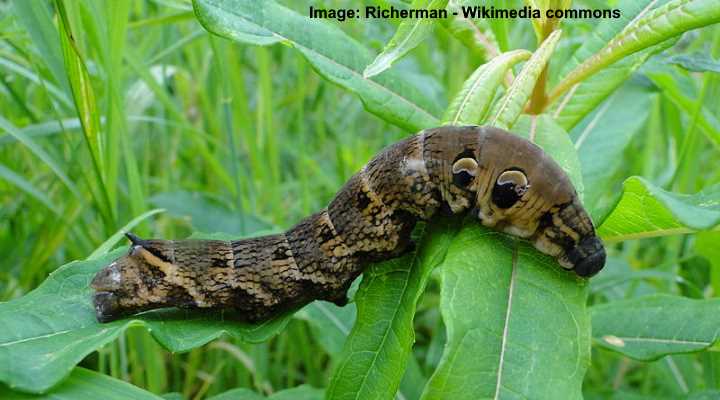
The large elephant hawk moth caterpillar has brown and black patterns on its body
The elephant hawk moth larva is a large, plump brown and black horned caterpillar with eye-like markings on its head. Before pupation, the mature caterpillar is a brown-dark gray color with black dots along its body. However, the immature slender larvae are bright green or yellowish-white.
The impressive brown, dark-gray and black horned caterpillar grows up to 3” (75 mm) long. After the pupal stage, the fat caterpillar is a stunning brown and pink furry moth with pale pink legs and antennae.
Black and brown caterpillar identification
The elephant hawk moth caterpillar is characterized by its brown body with black markings and spots and eye-like markings on its head.
- Adult Stage: Elephant Hawk Moth
- Host Plants: Willow herb, bedstraw, and other plants
- Habitat and Distribution: Gardens, meadows, and other open areas across Europe, including the United Kingdom, Germany, France, and other countries
- Stinging: Doesn’t sting
Scarce Dagger Moth Caterpillar (Acronicta auricoma)

The scarce dagger moth caterpillar has pale dots on the back of its black body with orange-brown spikes
The scarce dagger moth larva is a black hairy caterpillar covered in tufts of orangey-brown hairs emerging from yellowish bumps. The slender black and brown spiny creatures have an orange head with a dense covering of fine setae. In some instars, the caterpillar looks like a spiky black caterpillar with yellow dots.
Scarce dagger moth caterpillars are typically active from May until August. Then, after pupating, the black and orangey-brown-haired larva turns into a white and gray moth.
The spiny, fuzzy caterpillar is not a stinging variety. However, its hairs are irritating and can leave your skin itchy after handling it.
Black and brown caterpillar identification
The scarce dagger moth caterpillar is identified by its slender worm-like black body covered in tufts of pale brown or orange spines.
- Adult Stage: Gold Spangle Moth
- Host Plants: Various trees and shrubs, including birch, oak, and willow
- Habitat and Distribution: These caterpillars can be found in forests, woodlands, and other wooded areas in North America, including parts of the United States and Canada
- Stinging: Although not poisonous or toxic, the hairs on this furry black species can be irritating on your skin
Fox Moth Caterpillar (Macrothylacia rubi)

The furry fox moth caterpillar has rusty brown marking along its black body
The fox moth larva is a long, slender caterpillar, primarily black with rusty brown bands. The hairy caterpillar is covered in fine black setae with tufts of grayish white hairs along its sides. The furry creature also has a rounded head, eight prolegs, and six front legs.
The fox moth caterpillar is black and bright yellow in its initial instars. As it grows, the worm-like larva becomes darker and eventually dark brown and black with tawny hairs. The fox moth caterpillar eventually grows to 3.1” (80 mm) long.
Black and brown caterpillar identification
Identifying features of the fox moth caterpillar are its furry black and brown body covered in black or grayish tufts of fine hairs.
- Adult Stage: Fox Moth
- Host Plants: Feeds on various plants including heather, bilberry, and clover.
- Habitat and Distribution: Found in grasslands, heathlands, and moorlands across Europe and parts of Asia.
- Stinging: The Fox Moth Caterpillar does not have strong stinging capabilities, although its bristles may cause mild skin irritation in some people.
Pink-Spotted Hawkmoth Caterpillar (Agrius cingulata)

The large pink-spotted hawkmoth caterpillar has dark brown almost black body with orange lines and creamy patterns and pointed tail
The pink-spotted hawkmoth larva is an impressive dark brown caterpillar that looks almost black. The horned caterpillar has stunning markings with orange stripes along its back and triangular patterns with an eyespot on each segment. This large brown or black caterpillar measures 3.14” (80 mm) long.
The large, pink-spotted hawkmoth caterpillar is a significant pest in Texas where it feeds on sweet potato plants and can destroy entire crops.
Black and brown caterpillar identification
The pink-spotted hawkmoth caterpillar’s body is smooth and dark brown, with distinctive triangular creamy markings, orange stripes on its back, and a pointed tail horn.
- Adult Stage: Pink-spotted Hawk Moth
- Host Plants: Various plants, including members of the Convolvulaceae family such as sweet potato and morning glory
- Habitat and Distribution: This species is primarily found in diverse habitats across North and South America, with a particular presence in the United States and Canada. It can also be found in regions of Central and South America.
- Stinging: The caterpillar of Agrius cingulata does not possess stinging hairs or spines and is not known to cause significant skin irritation in humans.
Imperial Moth Caterpillar (Eacles imperialis)
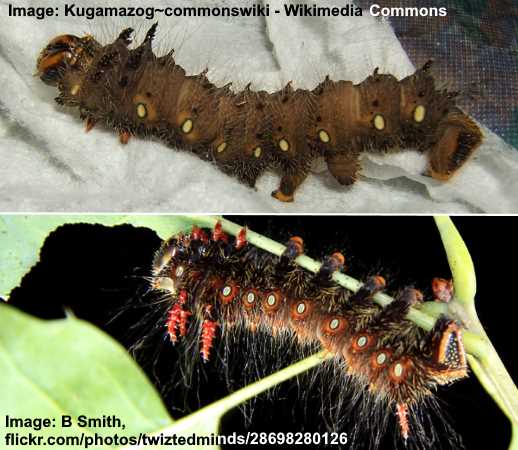
The large imperial moth caterpillar has color variations with dark brown and black spiny body and pale yellow spots along its sides
The imperial moth larva is a large dark brown and black caterpillar with spiny red horns, orange and yellow dots, and pale wispy spines. This dark hairy caterpillar can grow up to 5.5” (100 mm). The caterpillar has a fearsome appearance with its three red horns at its head and red tail horn.
The imperial moth caterpillar goes through various growth stages. The larva starts small, about 0.4” (10 mm) long, and is orange and black with long spines. As the caterpillar develops, it becomes longer and its spines shorter. Mature imperial moth caterpillars can be dark brown, green, or burgundy.
Black and brown caterpillar identification
The dark brown and black imperial moth caterpillar has a distinctive row of yellow-orange oval circles, fine hairs, and several fleshy red spines.
- Adult Stage: Imperial Moth
- Host Plants: Various trees, including but not limited to oak, pine, maple, and sassafras
- Habitat and Distribution: Found in forests and woodlands across North America, particularly in the eastern regions
- Stinging: The caterpillar of Eacles imperialis is not known to possess stinging hairs or cause significant skin irritation in humans. However, some individuals may experience mild skin irritation upon direct contact.
Salt Marsh Moth Caterpillar (Estigmene acrea)
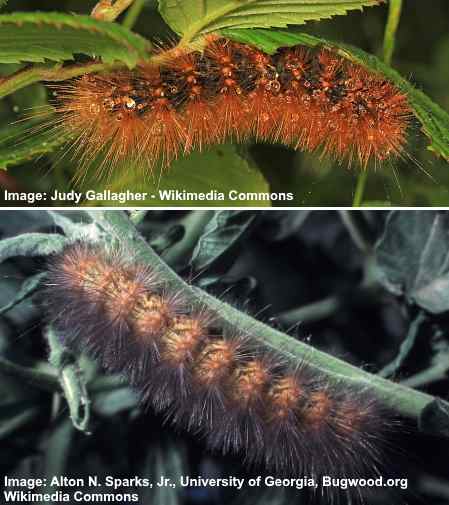
The hairy salt marsh caterpillar can vary in color from tan to dark brown, almost black
The salt marsh moth larva is a rusty brown and black caterpillar covered in tufts of dark orange or black spines. The hairy caterpillar has a tube-like body that measures 2” (50 mm) long. Other identifying features of the shaggy larva include warty orange growths and white dots.
Like many hairy caterpillars, the salt marsh moth caterpillar has several color variations. The fuzzy caterpillar’s body ranges in color from dark brownish black to rusty orange or pale yellow.
You can often find this furry caterpillar on host plants such as on cabbage, dandelions, clover, legumes, cotton plants, as well as walnut and apple trees.
- Adult Stage: The Salt Marsh Moth
- Host Plants: Dandelion, sunflower, clover, and various garden and field crops
- Habitat and Distribution: Found in gardens, meadows, fields, and coastal marshes across North and South America
- Stinging: These hairy caterpillars are not poisonous and do not have stinging hairs.
Common Buckeye Caterpillar (Junonia coenia)
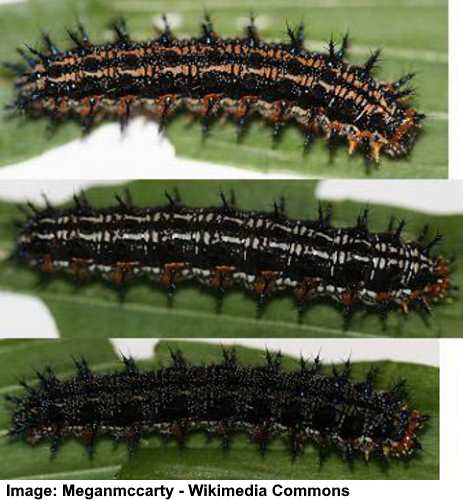
The black and brown common buckeye caterpillar has some color variations
The common buckeye butterfly larva is a spiky black caterpillar with brown stripes along its back. The black and brown insect has identifiable features like a reddish-orange head with black markings, orangey-brown spots, and a brown underside. The slender cylinder-shaped spiny black insects grow 1.5” (40 mm) long.
Common buckeye caterpillars have several variations in appearance. Some are black worm-like creatures covered in branched spines and tiny white dots. Others are black caterpillars with white stripes.
The common buckeye caterpillar is easily confused with the painted lady butterfly caterpillar and the Glanville fritillary butterfly larva.
Buckeye caterpillars adapt well to hot, dry climates and are common bugs in Arizona and other desert states.
Black and brown caterpillar identification
Common buckeye caterpillars are black with distinctive black branched spines, pale chocolatey-brown stripes, and orange-brown spots along their abdomen.
- Adult Stage: The adult stage is commonly known as the Buckeye Butterfly
- Host Plants: Its caterpillars feed on various plants, including those from the snapdragon family (Scrophulariaceae) and plants from the Acanthaceae family
- Habitat and Distribution: The Junonia coenia caterpillar can be found in open areas, gardens, roadsides, and meadows throughout North and South America
- Stinging: There are no reported instances of the Junonia coenia caterpillar causing skin irritation or stinging
Eastern Tent Caterpillar (Malacosoma americanum)
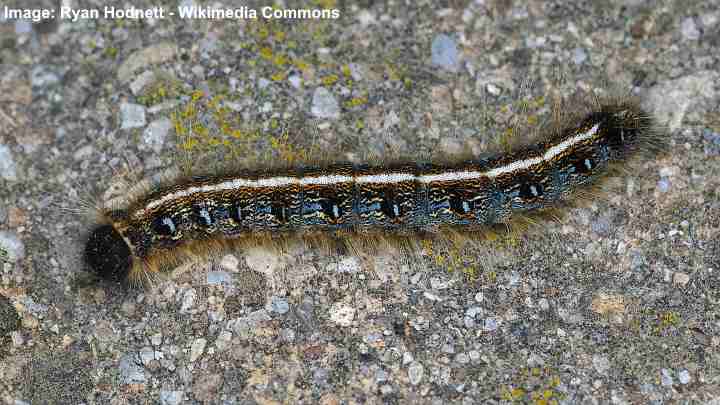
The large eastern tent caterpillar has a dark brown-blackish body with a distinct white line on its back
The eastern tent caterpillar is a slender, shiny dark brown-black insect with a conspicuous brown and white band along its back. Other characteristics of the caterpillar are its bulbous black head, yellowish setae, and bluish-black spots along its abdomen. The eastern tent caterpillar grows 2” (50 mm) long.
Tent caterpillars are easy to identify on trees as they have the habit of living in large, webbed tent-like structures. The striped, hairy brownish-black larvae feed en masse and are often spotted on deciduous trees in early and mid-spring.
Eastern tent caterpillars construct their tent-like nests in the forks of branches and feed on leaves outside the tent.
It’s worth noting that while Eastern tent caterpillars are more of a nuisance than a direct threat to tree health. In addition, they also create unsightly silken nests. These nests are constructed on the surfaces of branches where the caterpillars congregate. They can be an eyesore, especially when exposed due to extensive defoliation.
Tent caterpillars can be poisonous creatures to some animals, especially horses. Pregnant horses that eat tent caterpillars usually abort the fetus spontaneously.
Black and brown caterpillar identification
Eastern tent caterpillars are slender brownish-black tube-like creatures with tufts of yellowish setae and recognizable white stripes running from head to tail.
- Adult Stage: The Eastern Tent Caterpillar Moth
- Host Plants: Cherry, apple, and various fruit trees, along with other hardwood trees
- Habitat and Distribution: Found in forests, woodlands, and regions abundant with deciduous trees throughout North America
- Stinging: These caterpillars do not possess stinging hairs or mechanisms that cause skin irritation
Ruby Tiger Caterpillar (Phragmatobia fuliginosa)
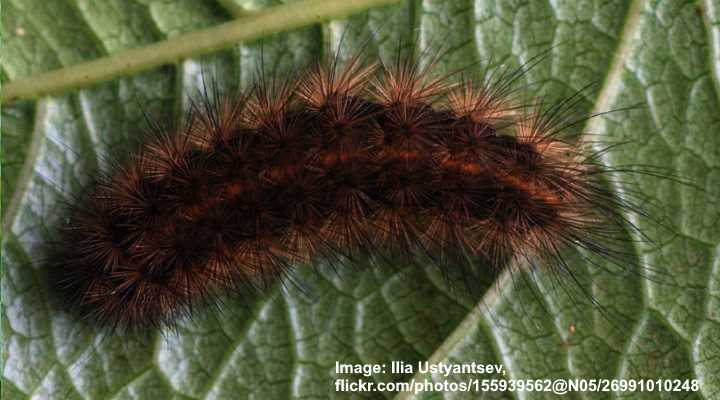
The small hairy brown and black ruby tiger caterpillar can have different color variations with dark or pale brown
The ruby tiger moth larva is a dark brown and black hairy caterpillar covered in foxy red hairs. Before pupation, the tiny hairy caterpillar only grows about 0.78” (20 mm).
This spine-covered larva has several color combinations. Some are black and hairy with pale brown stripes. However, they can also be primarily rusty brown with black patches.
The hairy brown and black caterpillar turns into the eye-catching ruby moth with bright orange and reddish-brown coloring.
Black and brown caterpillar identification
The ruby moth caterpillar is identified as a small dark brown and black hairy caterpillar.
- Adult Stage: Ruby tiger moth, a furry reddish moth
- Caterpillar Feeds on: Foliage of willow shrubs, cabbage, berry bushes, broadleaf plantain, and clover
- Habitat: Found in areas where its host plants grow; primarily found in Europe, including the United Kingdom
- Stinging: No, they do not have stinging hairs
Black Witch Moth Caterpillar (Ascalapha odorata)

The plump black witch moth caterpillar has mottled brown and black patterns on its body
The black witch moth larva is a giant black and brown caterpillar with mottled patterns, black stripes and brown spots. The engorged brownish-black crawling insect feeds on legumes and is prevalent in the southern United States. This cigar-like caterpillar grows up to 2.75” (70 mm) long.
The large black and brown caterpillar is common in Florida throughout the year and in Texas after the start of the rainy season.
Black and brown caterpillar identification
The black witch moth caterpillar is identified by its brown and black cylindrical body with three irregularly shaped light-colored blotches and two parallel stripes on its back.
- Adult Stage: The adult stage is known as the Black Witch Moth.
- Host Plants: Its caterpillars feed on various plants, including those from the legume and pea families, as well as plants like acacia, mesquite, and other trees and shrubs.
- Habitat and Distribution: The Ascalapha odorata caterpillar is commonly distributed in the southern United States, Central America, and South America.
- Stinging: The Ascalapha odorata caterpillar does not possess stinging hairs or mechanisms that cause skin irritation
Brown Tail Moth Caterpillar (Euproctis chrysorrhoea)

The brown-tail moth caterpillar has white marking and stinging hairs on its black or dark brown body
The brown tail moth larva is an eye-catching dark brown to black hairy caterpillar with white markings along its sides and two distinctive orange dots at its tail end. The blackish-brown caterpillar has bright orange patterns at its head and tufts of spines on the sides of each segment.
When mature, the white-spotted blackish brown tail moth caterpillar measures 1” (25 mm) long. The leaf-eating larvae feed on oak, maple, pear, and apple trees. This moth caterpillar is considered invasive and isn’t native to North America.
Black and brown caterpillar identification
The brown tail moth caterpillar is a hairy brownish-black caterpillar with tufts of yellowish setae along its sides, white and orange dots, and two conspicuous red spots on its rear segments.
- Adult Stage: Brown-tail moth, a small, white moth
- Host Plants: Various deciduous trees and shrubs, including oak, apple, and cherry trees
- Habitat: Woodlands, gardens, urban areas; primarily found in Europe, including countries like the United Kingdom and parts of continental Europe
- Stinging: The brown-tail moth caterpillar has stinging hairs on its body that can cause skin irritation upon contact
Black and Brown Caterpillars – FAQ
What do black and brown caterpillars turn into?
Black and brown caterpillars can transform into various species of moths or butterflies, depending on the specific species. Some common examples include the Isabella Tiger Moth, the Salt Marsh Moth, and the Buckeye Butterfly, among others. The specific transformation depends on the species of the caterpillar in question.
Can you touch brown and black fuzzy caterpillars?
Generally, it is advisable to avoid touching or handling any type of caterpillar with bare hands, including brown and black fuzzy caterpillars. While many caterpillars are harmless, some may have defensive mechanisms such as stinging hairs, spines, or toxins that can cause skin irritation, allergic reactions, or other health issues.
Related articles:
